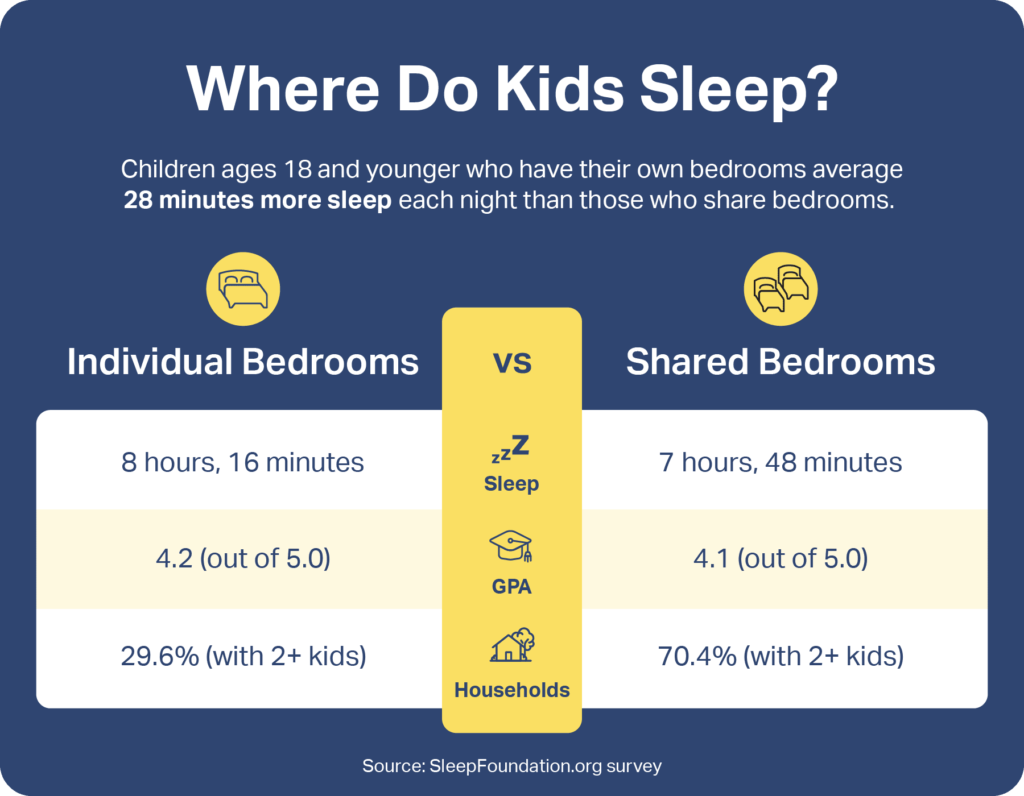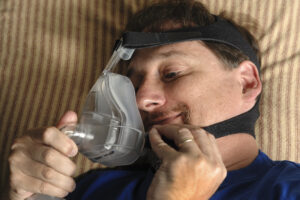Having Your Own Room as a Kid May Be Worth 28 Minutes of Sleep
- Children ages 18 and younger who share bedrooms sleep an average of 7 hours, 48 minutes each night, compared to 8 hours, 16 minutes for children in their own rooms.
- 70.4% of U.S. households with two or more children have kids sharing bedrooms.
- 72.2% of parents, guardians, and caregivers whose children share rooms say they’d give kids their own rooms if they could.
- 77.8% of shared bedrooms are composed of two children.
- 58.2% of parents, guardians, and caregivers agree they feel safer when their children sleep in a shared bedroom.
Many parents have heard their kids say they don’t want to share and don’t want to sleep. But children share bedrooms in 70.4% of households with two or more kids, according to a SleepFoundation.org survey of 1,250 U.S. parents and caregivers.
Considering 34.9% of children ages 17 and younger get less than the recommended amount of sleep for their age, this may present a question: Is there a difference between the sleep kids get in shared bedrooms versus sleep in their own rooms?
The answer: Yes, about 28 minutes of difference.
The SleepFoundation.org survey found that children in shared bedrooms slept an average of 7 hours and 48 minutes each night, compared to 8 hours and 16 minutes for children with their own rooms. That slipped to 7 hours and 39 minutes in households with combined incomes of $50,000 or less.

Recommendations for all age groups typically are for at least eight hours of sleep per night, with more recommended for younger children.
The story doesn’t end there, however. Shared bedrooms are often a necessity, and they may have a positive impact beyond minutes slept.
“If children must share a room, then the challenge becomes: Will this arrangement be a detriment to either child’s sleep?” says Wendy M. Troxel, Ph.D., a senior behavioral scientist at RAND Corp. and a SleepFoundation.org medical advisory board member. “Parents must be intentional and aware of each child’s sleep needs.”
How Bedrooms Translate to the Classroom
One of the chief concerns for parents of school-age children is school itself. One 2022 study found that once children are at the age where they start school, lack of sleep can hurt their brain function and brain structure, as well as their mental health.
“It’s during sleep where children’s brains consolidate everything they’ve learned throughout the day,” says Dr. Nilong Vyas, a pediatrician, founder of Sleepless in NOLA in New Orleans, and a SleepFoundation.org medical review panel member. “Long stretches of consistent sleep are especially crucial for kids from birth to age 5, when they are undergoing rapid developmental changes.”

That’s where sleep environments may come into play. Although surveyed parents and caregivers reported that children in individual bedrooms sleep more than those who share rooms, 64.6% of respondents say children who share bedrooms are well-rested. Only 28.1% say that their children who share bedrooms are tired during the day.
How does that translate to the classroom? Grade-point averages for children in individual bedrooms were slightly higher at 4.2 (out of a 5.0 scale) than those for children in shared bedrooms, at 4.1. Some 48% of children in individual bedrooms are A students, according to their parents or guardians, compared to 41.7% of children in shared bedrooms.

Meanwhile, only 26.9% of respondents thought their children’s grades suffered because they shared bedrooms.
The Perks of Kids Sharing Bedrooms
Many times, space dictates who sleeps where. In the survey, 76.2% of respondents say they place kids in individual bedrooms because they have room in the residence to do so. Meanwhile, 72.2% of respondents whose children share rooms agree that they would have their children sleep in separate bedrooms if they could.
But only 25.8% would not recommend to other parents or guardians that kids share rooms. There may be something to it.
“I’m a big proponent of children sharing bedrooms,” Dr. Vyas says. “Children can talk to one another and have that comfort of another body in the room if they wake in the middle of the night. And parents can use an extra bedroom for a playroom to keep the kids’ room focused on sleep instead of toys and play.”
Sharing a room creates a deep bond, teaches them to share, and builds good character. — Amy Neff, parent
While she notes that problems can arise when kids have different sleep personalities and needs, it all depends on how parents respond to the issue. According to the SleepFoundation.org survey, 80% of children in shared bedrooms wake up within one hour of one another. Some 36.7% wake up at the same time.
Surveyed parents think there are social and emotional benefits to room-sharing as well. More than half agree that their children in shared rooms are more socialized and get along better, with 76.4% saying they believe their children comfort each other.
That’s important to Amy Neff, a mom and writer in West Hartford, Connecticut. She says she always planned for her 3-year-old and 18-month-old sons to share a room.
“We have the space to give our children separate rooms, but I wanted them together,” she says. “Sharing a room creates a deep bond, teaches them to share, and builds good character.”
Sleep is a social behavior, Troxel adds, even though we might not always think of it that way.
I'm a big proponent of children sharing bedrooms. Children can talk to one another and have that comfort of another body in the room if they wake in the middle of the night, — Dr. Nilong Vyas, pediatrician
“When we sleep, that is a vulnerable state to be in,” she says. “Feeling more safe and secure in the presence of a family member or sibling can benefit children and their relationships.”
How to Help Kids Sleep More and Better in the Same Room
Sharing bedrooms is a longstanding practice often rooted in cultural norms. Even 60.6% of survey respondents say they shared a room with a sibling growing up.
Promoting sleep hygiene, a collection of habits and behaviors that allow for good sleep, is important for any parent or guardian, regardless of who is sleeping where. Here are five things that parents or guardians can add to children’s bedtime routines to maximize sleep if they are sharing rooms.
- Go dark. Sunlight coming into the bedroom can disrupt sleep cycles, so Dr. Vyas recommends making the room as dark as possible with blackout curtains or sleeping masks. She’s also a fan of nightlights and clocks that turn a certain color when it’s OK for children to wake up or get out of bed.
- Set ground rules. Make sure children sleeping in the same room understand your expectations of them, such as not waking their roommates and staying in bed.
- Reach for white noise. White noise is a great way to block out distracting sounds and help kids fall and stay asleep. Dr. Vyas recommends weaning them off after children can sleep through the night for one to two months.
- Get cozy. Dr. Vyas recommends stuffed animals and similar toys that toddlers and older children can associate with sleep to condition them to bedtime.
- Be flexible. In parenting, the only thing that remains constant is change, and that also goes for kids’ sleep. If one child needs some help relearning how to sleep at night after an illness or dropping a nap, separating kids may be an option, giving space to the child who needs it.
That’s what Dr. Vyas recommended for Giovanna Alvarez, a Miami-based physician and mom. She started working with Dr. Vyas when her twin girls, now almost 3 years old, were 9 months old and waking six times a night when sharing a room.
“It was really bad,” Alvarez says. “I would run in whenever one of the girls woke up and started screaming, hoping not to wake the other one, but I wasn’t giving them time to learn to self-soothe.”
If children must share a room, then the challenge becomes: Will this arrangement be a detriment to either child's sleep? — Wendy M. Troxel, RAND Corp.
After Alvarez separated the girls into different bedrooms, they started sleeping much better. Once everyone got the hang of it, Alvarez put them back in the same bedroom until they transitioned from cribs to toddler beds. That required another separate-room stint. Now, the girls are happily sleeping in the same room for 10 hours each night.
“They keep each other company, and we can easily do their bedtime together,” Alvarez says. “But soon, they may drop their naps, and then we may have to change things again. It’s a work in progress.”
Methodology
The survey commissioned by SleepFoundation.org was conducted on the online survey platform Pollfish between Aug. 12 and 14, 2022. Results are from 1,250 survey participants who were ages 18 and older; lived in the United States; and were a parent, guardian, or caregiver of two or more children at the time of the survey. All respondents attested to answering the survey questions truthfully and accurately.
References
3 Sources
-
Wheaton, A. G., & Claussen, A. H. (2021). Short sleep duration among infants, children, and adolescents aged 4 months–17 years — United States, 2016–2018. Morbidity and Mortality Weekly Report (MMWR), 70(38), 1315–1321.
https://www.cdc.gov/mmwr/volumes/70/wr/mm7038a1.htm -
American Academy of Pediatrics (Copyright 2016, last updated 11/16/2020). Retrieved Aug. 30, 2021 from, Retrieved Aug. 30, 2021 from
https://www.healthychildren.org/English/healthy-living/sleep/Pages/healthy-sleep-habits-how-many-hours-does-your-child-need.aspx -
Fan Nils Yang, Weizhen Xie, Ze Wang. Effects of sleep duration on neurocognitive development in early adolescents in the USA: a propensity score matched, longitudinal, observational study. The Lancet, July 29, 2022.
https://www.thelancet.com/journals/lanchi/article/PIIS2352-4642(22)00188-2/fulltext












































































